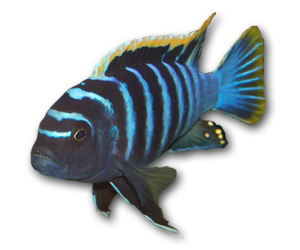Cynotilapia Afra

Quick Stats
| Size | 4" (10cm) |
|---|---|
| Tank | 180 litres + |
| Swimming Area | All |
| Ph | 7.8 to 8.6 |
| Temperature | 77ºF to 82ºF(22-28°C) |
| Food | Flaked, pelleted, live and frozen foods |
Common Name:
Cynotilapia Afra, Paratilapia Afra, Hemichromis Afra.
Distribution:
Africa, Lake Malawi. One of the Great Rift Lakes.
Colouration:
The coloration of the zebra can vary widely. Ranging from Blue to Albino morphs.
Lifespan:
10 years +
Maintenance:
10 to 20% weekly water changes. Keeping the Zebras is not difficult as long as certain requirements are met. They should be kept in a large community aquarium with other Mbuna type fish like the species from the Labeotropheus, Melanochromis as well as others from the Pseudotropheus Genus.
Feeding:
Feeding is not a problem as all types of food are taken, weather flake or frozen, it should contain a high content of plant material. live food like earthworms and the such should be offered only occasionally as they are low in fibers and not the best choice.
Substrate:
Crushed Coral Sand. These guys dig!
Tank Decor:
The aquarium should try to mimic the natural rubble zone where they live. This includes extensive rockwork with caves and other hiding places that kind of divide the tank into different territories. Plants are not needed and will be constantly dug up by the fish.
Filtration:
Provide good filtration and do frequent water changes.
Biotype:
Rocky regions of the lake free of sediment.
Breeding:
Breeding of the fish from the Rift Lakes is one of the most fascinating things a hobbyist can observe. They are known as mouthbrooders. No bonding takes place between the male and females of the species and unlike their South American cousins one female will not be enough for the male. You should have at least a ratio of three females to each male in the tank. Right after the spawning males and females go their own ways and only the mother will care for the eggs and fry. The preferred spawning site is a flat stone in a covered secluded place. The eggs are still unfertilized when the female takes them in her mouth. They are fertilized when the female follows the male with her mouth close to his anal fin. The egg spots play an important role as it is thought that the female believes these are more eggs and goes to retrieve them. At this moment the male releases his sperm and fertilizes the eggs in her mouth. The eggs are rich with yolk and take a long time to hatch. Once hatched the yolk sac takes about 20 days to be absorbed. Due to their larger size the fry can be fed finely crushed flake food or even Daphnia if you can find it. If raised in a community setting special feeding should not be needed as the fry will be able to find small left over food particles floating in the tank. One of the best things to observe is the fry retreating back into the mothers mouth when danger nears.